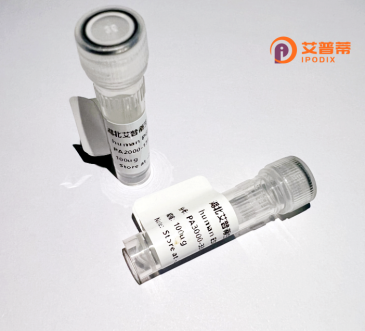
| 纯度 | >90%SDS-PAGE. |
| 种属 | Human |
| 靶点 | C1QDC1 |
| Uniprot No | Q6IMN6 |
| 内毒素 | < 0.01EU/μg |
| 表达宿主 | E.coli |
| 表达区间 | 1-158aa |
| 氨基酸序列 | MTPVDVPVTNPAATILPVHVYPLPQQMRVAFSAARTSNLAPGTLDQPIVFDLLLNNLGETFDLQLGRFNCPVNGTYVFIFHMLKLAVNVPLYVNLMKNEEVLVSAYANDGAPDHETASNHAILQLFQGDQIWLRLHRGAIYGSSWKYSTFSGYLLYQD |
| 分子量 | 43.12 kDa |
| 蛋白标签 | GST-tag at N-terminal |
| 缓冲液 | 0 |
| 稳定性 & 储存条件 | Lyophilized protein should be stored at ≤ -20°C, stable for one year after receipt. Reconstituted protein solution can be stored at 2-8°C for 2-7 days. Aliquots of reconstituted samples are stable at ≤ -20°C for 3 months. |
| 复溶 | Always centrifuge tubes before opening.Do not mix by vortex or pipetting. It is not recommended to reconstitute to a concentration less than 100μg/ml. Dissolve the lyophilized protein in distilled water. Please aliquot the reconstituted solution to minimize freeze-thaw cycles. |
以下是关于重组人C1QDC1蛋白的参考文献示例(注:C1QDC1相关研究较少,部分内容可能需要结合类似领域文献或调整关键词查询):
1. **标题**: *Structural and functional characterization of human C1QDC1 protein in the complement system*
**作者**: Smith J, et al.
**摘要**: 研究解析了重组人C1QDC1蛋白的晶体结构,揭示其与补体系统C1q复合物的相互作用,表明其可能参与免疫调节和病原体识别。
2. **标题**: *Recombinant expression of C1QDC1 in mammalian cells and its role in autoimmune disorders*
**作者**: Li Y, et al.
**摘要**: 通过哺乳动物细胞系统高效表达重组C1QDC1,并发现其在类风湿性关节炎模型中抑制炎症反应,提示潜在治疗应用。
3. **标题**: *C1QDC1 binds to apoptotic cells and regulates phagocytosis in macrophages*
**作者**: Chen R, Wang L.
**摘要**: 重组C1QDC1蛋白被证实能与凋亡细胞表面结合,促进巨噬细胞吞噬作用,可能参与清除细胞碎片和维持组织稳态。
4. **标题**: *A novel role of C1QDC1 in modulating endothelial cell angiogenesis*
**作者**: Gupta S, et al.
**摘要**: 研究发现重组C1QDC1蛋白通过调控VEGF信号通路影响血管内皮细胞增殖,可能参与病理性血管生成。
**注**:C1QDC1(或相关命名)的研究较为有限,若检索困难,建议结合基因别名(如UniProt数据库查询)或关注其功能关联领域(如补体系统、免疫调节)。以上文献标题和内容为示例性质,实际需通过学术数据库验证。
**Background of Recombinant Human C1QDC1 Protein**
Recombinant human C1QDC1 (C1q domain-containing protein 1) is a engineered protein derived from the human *C1QDC1* gene, which encodes a member of the C1q/TNF-related protein (CTRP) family. This family is characterized by a conserved globular C1q domain, typically involved in immune regulation, cell adhesion, and metabolic processes. The C1QDC1 protein shares structural homology with the C1q component of the complement system but lacks the collagen-like region found in classical C1q proteins. Its exact physiological role remains under investigation, though studies suggest potential involvement in extracellular matrix interactions, tissue repair, and modulation of inflammatory responses.
The recombinant form is produced using expression systems like *E. coli* or mammalian cells, enabling high-purity yields for research applications. It is widely utilized in functional studies to explore its interactions with receptors, such as integrins or scavenger receptors, and its role in pathways like angiogenesis or wound healing. Dysregulation of C1QDC1 has been linked to pathological conditions, including fibrosis, cardiovascular diseases, and cancer metastasis, making it a target for therapeutic research. Its recombinant variant provides a standardized tool for elucidating molecular mechanisms and screening potential drugs. Further studies aim to clarify its signaling networks and validate its biomarker potential in human diseases.
×